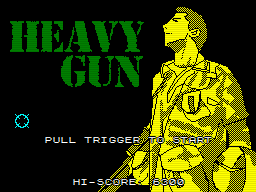Heavy Gun
Light Gun, © KesieV 2016

Light guns were the quite popular gun-shaped videogame controllers that accompanied gamers from the 8-bit and arcade age till the Playstation age. From cults titles like Nintendo Duck Hunt (1984) and the Namco Time Crisis (1995) passing through sightly more obscure but very innovative games like Sega Rescue Mission (1988), light gun based games had a very prestigious past and probably for a reason.
In light gun videogames, the player and its digital avatar are using the same object in the very same way, offering an unprecedented immersive experience and breaking the fourth wall for the entire experience: the player is truly into the game. But what I've always found equally fun about the whole light gun affair is how these things worked. Some people think that some laser is fired by the gun to the TV hitting the target, but this behaviour, hinted by the shape of the controller, is wrong and the true is the whole opposite.
Long story short, a first generation of guns, in which we can found our beloved Nintendo Zapper, used a diode for reading if the pointed part of the TV screen is white or not. Target were sequentially replaced with white boxes for a fraction of second and then the diode is tested, so the game knows which target was hit. Everything happens in a fraction of second, so all we see is a black screen with some white boxes for a very short while: the game uses humans slow persistence of vision in order to give them the illusion of shooting something.
A second and more refined one was based on how cathode tube TVs works. Images are drawn by a single electron beam moving sequentially on the rows of the screen at very fast speed and hitting a phosphor layer which gives it a color: due to the slow persistence of vision of humans we talked about before, people just see a whole colored image instead of a single moving dot. 2nd generation light guns, when the trigger was pulled, calculates how long it takes this electron beam to excite the phosphor at the location at which the gun is pointed and, together with the screen refresh rate, the game understand how the gun was pointed. No more black screens and improved precision, voilat!
This technique of drawing on the screen has been replaced in modern displays, resulting in more clear and precise images - but making these light guns useless. But is fascinating how something considered as a defect can be cleverly used as a great feature.
It is not so different from computer hacking and, hey, can we try to learn something from that, right? Learning from errors and being aware of our defects is key and we heard this lesson over and over again. But we are humans - clever and imperfect. So, while we try to find out how to fix all these 'imperfections' on ourselves, why don't we find out a good use for them?
Meanwhile, inspired by these games and the great Taito game Operation Wolf (1984) (which used another type of gun but... forget that.) I've added mouse/touch screen support to the Wright! engine, so...
Plot!
Well done, soldier! You managed to steal important intel files behind the enemies lines... now is the time to bring them back! Escape from the military base and defend yourself with your trusty gun! Use your POINTER (i.e. your mouse) for moving the reticle around the screen and the TRIGGER (i.e. mouse left button or touch the screen) for firing. Fire at ammo box for collecting them and try to survive as much as you can!
(Want to share something? You can find me on Twitter!)
 Install / Add to home
Install / Add to home
 View game sources
...or play it online below!
View game sources
...or play it online below!